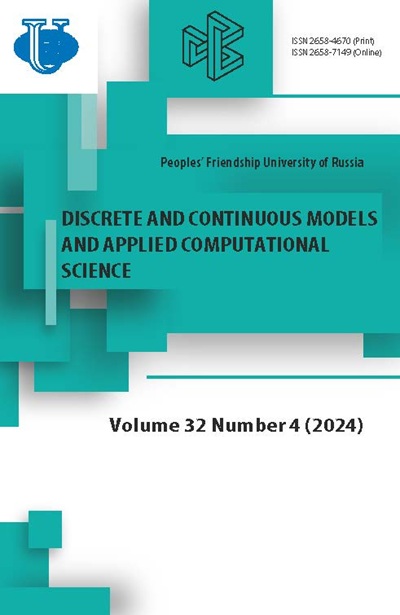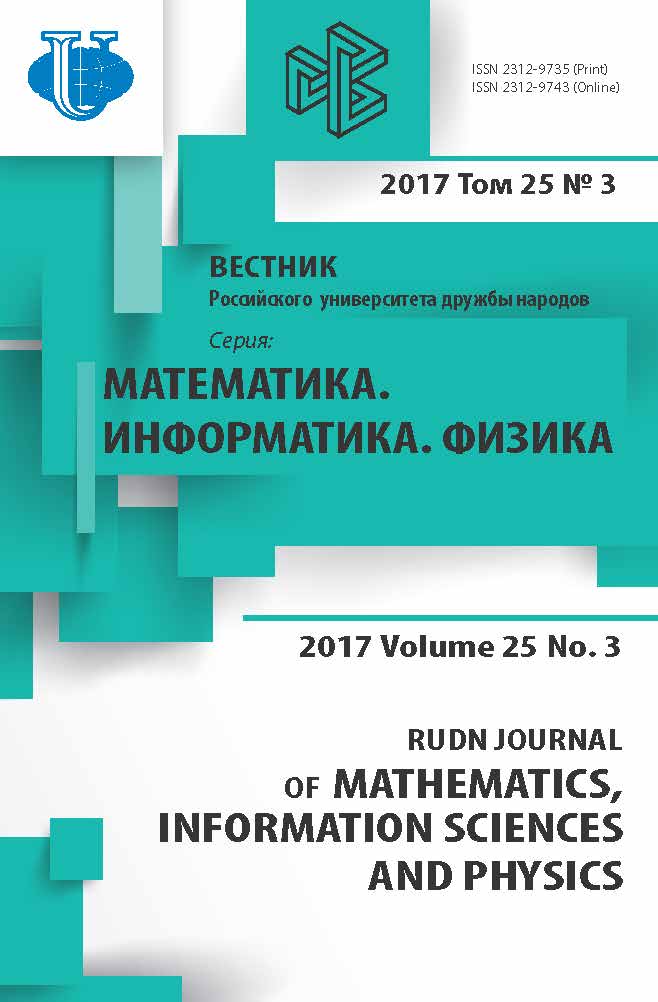Том 25, № 3 (2017)
- Год: 2017
- Статей: 10
- URL: https://journals.rudn.ru/miph/issue/view/970
- DOI: https://doi.org/10.22363/2312-9735-2017-25-3
Весь выпуск
Математическая теория телетрафика и сети телекоммуникаций
К вычислению вероятностных характеристик СМО ограниченной ёмкости со случайными требованиями к ресурсам
Аннотация
Для современных сетей связи характерен высокий уровень роста мобильного трафика данных. Устойчивые тенденции роста нагрузки в беспроводных сетях ускоряют развитие технологий и переход к сетям нового поколения (5G). Планируемые улучшения позволят в несколько раз увеличить пропускную способность каналов связи и позволят устройствам одновременно поддерживать как соединения сотой связи, так и, например, подключение к Wi-Fi сетям, возможна передача данных от устройства к устройству напрямую (device-to-device, D2D). В условиях вынужденной гетерогенности сетей связи предлагается отказаться от традиционной «парной» ассоциации восходящего (ВК) и нисходящего (НК) каналов и разделять их при условии гарантии необходимого уровня качества. Разделение ресурсов в современных гетерогенных сетях предлагается моделировать в виде системы массового обслуживания (СМО) со случайными требованиями. Подобные модели к анализу показателей качества в беспроводных сетях ранее не применялись. Исследуется многолинейная СМО с различными классами заявок, где каждой поступившей заявке выделяется некоторый вектор случайных требований к ресурсам. Было доказано, что при объединении потоков заявок различных классов в один поток со средневзвешенным требованием стационарные вероятности не зависят от порядка поступления заявок, а зависят от их общего числа в системе и объёма занимаемых ресурсов. Получен более простой вид формул для вероятности блокировки и среднего объёма занятых ресурсов, однако аналитические формулы требуют вычисления n-кратных свёрток для всех возможных наборов векторов занимаемых ресурсов, где n - количество заявок в системе. Был разработан эффективный алгоритм вычисления нормировочной константы, с помощью которой получены рекуррентные формулы для стационарных вероятностей и основных вероятностных характеристик СМО.
 209-216
209-216


Математическое моделирование
Применение метода гармонической линеаризации к исследованию автоколебательного режима систем с управлением
Аннотация
В сетях передачи данных, реализуемых как системы с управлением, может возникать явление глобальной синхронизации. Внешне это явление проявляется как автоколебательный режим в системе, который негативным образом влияет на такие характеристики системы как пропускная способность и задержки передачи. Ранее авторами исследовалась задача нахождения зон возникновения автоколебаний для системы в целом. Авторам представляется актуальной задача выделения элементов системы, ответственных за возникновение автоколебательного режима. Сложность этой задачи вызвана существенно нелинейным характером системы и её элементов. Зачастую для декомпозиции системы применяют метод линеаризации. Но в этом случае пропадает автоколебательный режим. Таким образом возникает необходимость поиска метода декомпозиции, не разрушающего автоколебательный режим системы. В качестве такого метода авторы предлагают использовать метод гармонической линеаризации, применяемый в теории автоматического управления. Однако приходится признать, что данный математический аппарат мало знаком исследователям, специализирующимся на исследовании систем и сетей передачи данных. Авторы постарались как можно более подробно описать применение метода гармонической линеаризации к исследованию влияния функции сброса пакетов по алгоритму RED в системе с управлением на процесс возникновения автоколебательного режима. Таким образом, данный материал носит скорее методический, чем исследовательский характер.
 234-252
234-252


Метод конечных элементов высокого порядка точности решения краевых задач для эллиптического уравнения в частных производных
Аннотация
Предложена новая вычислительная схема метода конечных элементов высокого порядка точности решения краевых задач для эллиптического уравнения в частных производных, сохраняющая непрерывность производных приближенного решения в ограниченной области многомерного евклидова пространства. Кусочно-непрерывный базис метода конечных элементов генерируется с помощью интерполяционных полиномов Эрмита нескольких переменных и обеспечивает непрерывность не только приближенного решения, но и его производных до заданного порядка на границах конечных элементов в зависимости от гладкости переменных коэффициентов уравнения и границы области. Эффективность и порядок точности вычислительной схемы, алгоритма и программы демонстрируется на примере точно-решаемой краевой задачи на собственные значения для треугольной мембраны в зависимости от числа конечных элементов разбиения области и от размерности собственного вектора алгебраической задачи. Показано, что для достижения заданной точности приближённого решения схемой метода конечных элементов с интерполяционными полиномами Эрмита длина собственного вектора примерно в два раза меньше, чем для схем с интерполяционными полиномами Лагранжа, сохраняющих на границах конечных элементов только непрерывность приближённого решения. Вычислительная схема метода конечных элементов высокого порядка точности ориентирована на расчёты спектральных и оптических характеристик квантовомеханических систем.
 217-233
217-233


Краевая задача для уравнения эллиптического типа в области с углом в математическом моделировании магнитных систем
Аннотация
Современные ускорительные системы и детекторы содержат магнитные системы сложной геометрической конфигурации. Проектирование и оптимизация магнитных систем требует решения нелинейной краевой задачи магнитостатики. Область, в которой решается краевая задача, состоит из двух подобластей: область вакуума и область ферромагнетика. Из-за сложной геометрической конфигурации магнитных систем граница раздела сред ферромагнетик/вакуум может являться негладкой, то есть содержать угловую точку, в окрестности которой граница образована двумя гладкими кривыми, пересекающимися в угловой точке под некоторым углом. В связи с тем, что решение краевой задачи приходится искать численными методами, встает вопрос о поведении решения в окрестности угловой точки ферромагнетика. Показано, что если функция магнитной проницаемости удовлетворяет определенным условиям, то соответствующее решение краевой задачи будет иметь ограниченный градиент. Дается верхняя оценка допустимого роста магнитного поля в окрестности угловой точки. На основании полученной оценки предлагается метод сгущения разностной сетки вблизи угловой точки, учитывающий характер поведения решения краевой задачи. Приводятся примеры расчета магнитных систем в области, содержащей «угловую точку».
 253-265
253-265


Физика
Магнитные возбуждения графена в рамках 8-спинорной реализации киральной модели
Аннотация
Простейшая киральная модель графена, предложенная ранее и основанная на SU(2) параметре порядка, обобщается путем введения 8-спинорного поля как дополнительного параметра порядка для описания спиновых (магнитных) возбуждений в графене. В качестве иллюстрации мы изучаем взаимодействие графенового слоя с внешним магнитным полем. В случае магнитного поля, параллельного графеновой плоскости, предсказывается диамагнитный эффект, т. е. ослабление магнитной индукции внутри образца. Однако в случае магнитного поля, ортогонального графеновой плоскости, обнаруживается усиление магнитной индукции в центральной области (при малых r). Таким образом, магнитные свойства графена оказываются сильно анизотропными.
 266-275
266-275


Оператор давления для осциллятора Пёшля-Теллера
Аннотация
Рассмотрены квантово-механические свойства сильно нелинейного квантового осциллятора в модели Пёшля-Теллера. Изучен энергетический спектр модели и его зависимость от параметра конфайнмента, или эффективной ширины потенциала. На основе теоремы Гельмана-Фейнмана получен оператор давления для указанной модели, который вместе с энергетическим спектром изучен в двух основных приближениях: частицы в ящике и линейного гармонического осциллятора для больших и малых значений главного квантового числа n соответственно; получено также значение критического значения nкр. Рассмотрены также квазиклассическое приближение и теория возмущений для обоих предельных случаев. Полученные результаты предназначены для использования в последующих термодинамических приложениях - прежде всего, обобщения хорошо известного результата Блоха для линейного гармонического осциллятора в термостате. С этой целью необходимо построить матрицу плотности для осциллятора Пёшля-Теллера для проведения полного цикла Карно.
 276-282
276-282


Об эволюции сходящегося волнового пакета перевёрнутого квантового осциллятора, вынуждаемого однородным гармоническим полем
Аннотация
Исследуется модель периодически возмущаемого однородным полем квантового одномерного перевернутого осциллятора с гамильтонианом, широко используемая для описания поведения нестабильных молекулярных/ионных комплексов в поле лазерного излучения. Аналитически и численно при помощи Maple 17 решается нестационарное уравнение Шрёдингера (НУШ) с начальной волновой функцией (в.ф.) обобщенного Гауссовского типа, наилучшим образом удовлетворяющей оператору начальных условий (НУ). Её волновой пакет с изначально аномально большой безразмерной шириной описывает сходящийся поток плотности вероятности, и на безразмерных временах он сначала коллапсирует в экстремально узкую область ширины порядка, а затем неограниченно расширяется по показательному закону. При этом для определённых значений фаз j, определяемых возмущаемой частотой лазера W и исходным разбросом s0, центр масс волнового пакета оставался вблизи положения равновесия в течение примерно двух «естественных периодов» осциллятора, колеблясь и дрейфуя, после чего быстро уходил к бесконечности. Фазы j служили точками бифуркации направления ухода центра пакета, и при они удовлетворяли хорошо классической формуле; поведение стабилизирующей фазы на «резонансной» частоте хорошо описывалось перевёрнутой и смещённой формулой Ферми-Дирака из квантовой статистики.
 283-294
283-294


Информатика и вычислительная техника
Современные технологии интеграции информации из независимых источников и их применение при построении информационной системы, объединяющей транспортные расписания
Аннотация
Рассматривается задача объединения в единое целое автобусных расписаний, предоставленных различными источниками - автобусными парками, независимыми друг от друга и, возможно, находящимися в разных регионах страны. Эта объединённая система предназначена, в частности, для удобства поиска имеющихся автобусных маршрутов между двумя заданными точками. Для решения рассматриваемой задачи предлагается использовать комбинированный подход, сочетающий преимущества технологий медиаторов и хранилищ. В статье рассматривается модель из трёх источников данных, которыми являются автобусные парки, выставляющие информацию о своих расписаниях. Предполагается, что все источники имеют сходные концептуальные схемы, но обладают своими особенностями. В частности, могут быть разные наименования таблиц и атрибутов на разных источниках и разное распределение атрибутов по таблицам. Возможно также отсутствие некоторых атрибутов на отдельных источниках. Строятся таблицы соответствия и медиатор, транслирующий пользовательские запросы на источники. При этом для идентификации нужных источников поддерживается вспомогательное хранилище небольшого объёма, которое содержит информацию об остановочных пунктах, обслуживаемых каждым из источников. Описывается технология обновления хранилища и схема исполнения пользовательского запроса, использующая информацию, содержащуюся в хранилище.
 295-305
295-305


Сведения об авторах
 306-307
306-307


Правила оформления статей
 308-309
308-309
















